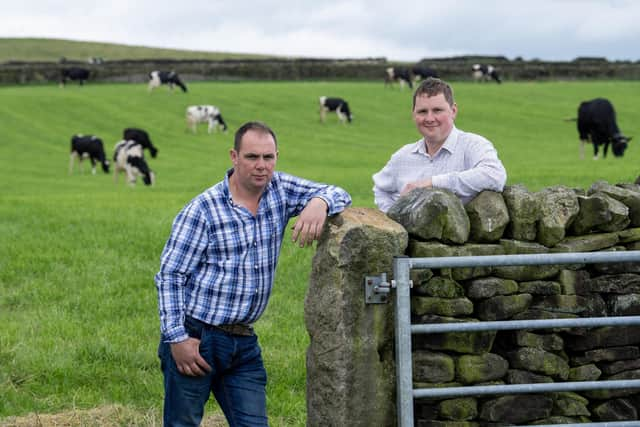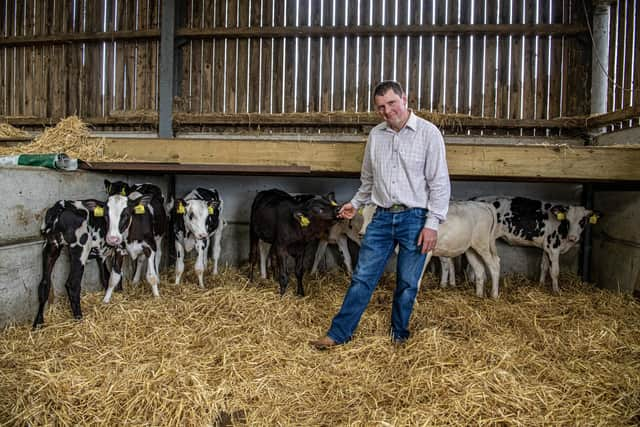Farm of the Week: Brothers who need robust cows for upland dairy operation in the windy moors
Brothers Andrew and Ben Walker are dairy and sheep farmers with their parents Richard and Marion at Coppy Hill Farm, Laycock near Keighley, which is situated at 1000ft above sea level. They also have land seven miles away at Moorlands Farm, East Morton where the brothers grew up and the farm had its base until 2017.
“We’re farming a lot of Tarmac,” says Andrew, of the distance between both, that sees them farming 450 acres in total, with 260 acres at Coppy Hill.
Advertisement
Hide AdAdvertisement
Hide Ad“We needed to invest in new facilities for our dairy herd that now runs to 180 dairy cows and our access at Moorlands Farm was quite poor, you had to go past a lot of houses and was not good for either milk tankers of today’s farm equipment. We own more land at Coppy where we are also much less restricted and have also built our own road. It looked a better prospect to spend a lot of money at Coppy rather than Moorlands.


“We’d bought 40 acres here at Coppy in the 70s and gradually added more acreage. We’d had young stock and sheep here previously, but we’d never intended milking here until 12 months before we did so, it’s just how things panned out and it felt a better way to do things. We made the decision in 2017, started building the new dairy housing and parlour in late summer that year and started milking the cows here in January 2018.
Andrew says that the move also brought about changes to their ways of sheep farming and their dairy herd.
“Because we are at 1000ft we want the wind to go around the cows, not through them. Holsteins would just fall over up here, so what we want is a medium sized, well-put-together, robust dairy cow.
Advertisement
Hide AdAdvertisement
Hide Ad“Our dairy herd is predominantly Holstein Friesian black and whites, plus we have some red and whites. We are using red and white Holstein Friesian AI and some Dairy Shorthorn across the herd to provide longevity and hybrid vigour.


“As the cows are now in really nice new sheds it seems better for their own welfare and cow health to leave them inside. Our herd average yield is around 9500 litres per lactation.
“We have 300 breeding ewes, which are made up of North of England Mules and some three-quarterbred Texels, and now lamb inside, utilising the new buildings. That has been a real game changer for all of us. Gone are the days of trailing round on a quad bike bringing in sheep in the pouring rain.
Andrew says they considered putting in robotic milking but went down the more traditional route.
Advertisement
Hide AdAdvertisement
Hide Ad“We put a new milking parlour in, as opposed to robots, because we just felt it gave us more flexibility if we wanted them inside or out, and also because if we wanted any further herd expansion it just seemed a bit more flexible. Our dry cows and low yielders, cows that are giving below 30 litres a day, go outside.
“Our only forage is silage from the grass. We take in three cuts, which we need up here as we have long winters. The silage is added to with cake in the parlour, feeding a complete mixed ration, including brewers’ grains from our local brewers Timothy Taylor’s that we fetch ourselves, some caustic wheat and a few other little bits of goodies.
Similar to many other dairy farming enterprises the Walkers are now using sexed semen on their top cows to produce replacements and quality calven heifers for the livestock market. Andrew tells of how they manage their calving and head of stock.
“We use quite a lot of sexed semen for up to the first two services on the right cow, a bit of conventional semen and also Angus and Belgian Blue. We’re calving around 80 dairy heifers a year of which we sell half of what we calve as newly calven heifers, mainly through Gisburn livestock market where there is a good trade.
Advertisement
Hide AdAdvertisement
Hide Ad“We’ve about 420 head of cattle on in total, that includes milk cows, followers and a few stores. We tend to keep Belgian Blue and Aberdeen Angus heifers because they’re fit and don’t cause any problems running with the Holstein Friesian heifers. We sell bull calves at Wharfedale livestock market in Otley at a month old.
Coppy Hill’s milk goes to Dales Dairies in Grassington. Andrew explains that it is a good relationship between the dairy and themselves.
“We’ve been selling to Dales for eight years. We like Dales Dairies as it is not far away and is even getting closer to us as they have recently moved half of their operation to Keighley.
“It feels good selling milk locally. We used to bottle and sell ourselves at Moorlands. Grandad had his own round and we supplied others, but then milk became worth more on the milk tanker than on doorstep at one time.
Advertisement
Hide AdAdvertisement
Hide AdLocal trading of both milk and livestock is an important part of the family’s system. Richard is also a director at Wharfedale Farmers Livestock Market in Otley.
“Wharfedale has a lot of private butchers for nice shaped Texels,” says Andrew. “We lamb from the middle of March onwards and it’s all our fat lambs that go through Wharfedale along with stores and calves.
Andrew says they managed to get their second cut in just last week, a little later this year.
“The three cuts for silage are usually around the end of May, middle of July, and the second week September. We weren’t ready to go for the second cut, and then as soon as it started raining we were ready to go, but we managed to get that last week in good condition in two good days.
Advertisement
Hide AdAdvertisement
Hide Ad“We manage our grassland and have done quite lot of reseeding ourselves. We’ve done 50 acres in the last few years. It usually follows other projects such as drainage, cutting trees and sorting boundaries out. Reseeding seems an easy project once you’ve done the other jobs and in our case is the best money you can spend.
“We’ve not done much previously on environmental schemes but just last Friday we hosted a meeting here of a group of farmers to look at our options. We are wanting to establish more clover in our leys so we don’t have to buy as much fertiliser and that’s an option under both SFI and Mid-Tier stewardship.
Andrew says there was never any doubt that he and his brother were going to follow on as the next generation.
“We were always going to farm. I went to Bishop Burton College and Ben went to Askham Bryan College. Our one get-out from the farm today is Lothersdale Agricultural Discussion Group. We make sure we go because it’s once a month and if you don’t make the effort you don’t go anywhere.
“Ben and I have young families. We are committed to our farming futures and we’re happy here at Coppy. We still have sheep, grassland and young stock at Moorlands.